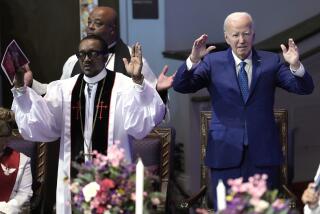Ministry Can Use Guidance on AIDS
- Share via
A group of primarily African American clergy from across the state recently announced the printing and eventual statewide distribution of a book designed to help clergy write sermons dealing with HIV/AIDS. The guidebook, “Healing Begins Here: A Pastor’s Guidebook for HIV/AIDS Ministry Through the Church,” addresses a long-standing criticism that the clergy has ignored the HIV/AIDS issue in its ministry.
A recent study showed that African American women are the fastest-growing segment of those infected by the HIV-AIDS virus.
When the AIDS epidemic first became an issue in the African American community, gay men were still the most affected segment of the population. While male-to-male transmission is still the leading cause of infection, health care officials increasingly are seeing heterosexual female African Americans and Latinas turning up HIV-positive.
The guidebook is an attempt by the African American clergy to face an issue that critics and activists have long accused them of ignoring.
JANNISE JOHNSON spoke with a senior pastor of a church with a primarily African American and Latino congregation.
CLYDE W. ODEN JR.
Senior pastor, Holy Trinity African Methodist Episcopal Church, North Long Beach.
It’s good that there is a guidebook and very good that there is a formal discussion of this issue among the faith community. In the case of ministers, it’s not enough to be a good generalist. In the case of HIV/AIDS, we see that African American women are affected seven or eight times at the rate of white women.
I see the faith community as one of the segments of the African American community that must become more attuned to this.
I think the African American churches were not active in dealing with this issue for a number of reasons. One, because the disease was initially identified as being in the gay community. And second, the whole issue of dealing with sexuality and the notions around that had caused many churches to bite their tongues and not really get beyond the headlines. So it was a discomfort that was found in many pulpits and what brought it around was the fact that the problem didn’t go away. Ignoring it didn’t cause the problem to disappear.
I think that most of the ministers and pastors will see this guidebook as a helpful aid in their ministry. I would be surprised if there was any outward hostility or negativity toward the book because most pastors welcome any assistance they can get that will allow them to become more effective serving their congregation.
I’m an optometrist and I do have specialized community health training. But because I’m also a pastor I can also know that the [ministerial] training did not deal with this disease. When I was in seminary, they dealt with cancer and the issues of aging.
We have members of our congregations who are living with HIV and AIDS and we have members who are living with people who have HIV and AIDS.
It is my opinion that the African American community must own up to this disease. It’s a disease of living and it’s a disease that can only be abated by changing behavior and knowing how the disease functions.
The African American church now is responding to the challenges of AIDS and HIV infections in the community, and there’s just much more that needs to be done not only by the African American church but also by all the other segments in the community. This is a problem that begs for a holistic approach.
More to Read
Sign up for Essential California
The most important California stories and recommendations in your inbox every morning.
You may occasionally receive promotional content from the Los Angeles Times.













